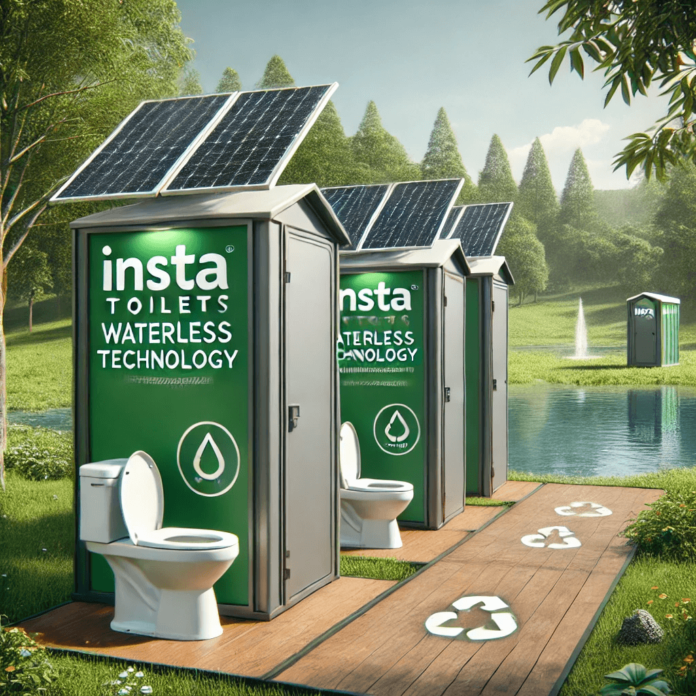Introduction
- Why Choose Eco-Friendly Insta Toilets for Your Next Event?
- 1. Waterless Technology: Conserving a Precious Resource
- 2. Eco-Friendly Waste Management: Reducing Harmful Chemical Use
- 3. Solar-Powered Units: Harnessing Renewable Energy
- 4. Recyclable and Biodegradable Materials: Reducing Waste
- 5. Less Frequent Servicing: Cutting Down on Emissions
- 6. Positive Impact on Wildlife and Natural Habitats
- 7. Supporting Sustainable Events and Green Certifications
- Conclusion:
As the need for sustainable solutions grows, eco-friendly Insta Toilets have emerged as a superior alternative to traditional portable sanitation options. These green portable toilets are designed to minimize environmental impact by using waterless technology, recyclable materials, and solar-powered systems. Unlike traditional units, environmentally friendly Insta Toilets offer a cleaner, greener, and more efficient way to manage waste, making them the perfect choice for eco-conscious users at events, construction sites, and outdoor venues.
Why Choose Eco-Friendly Insta Toilets for Your Next Event?

Eco-friendly Insta Toilets offer a modern solution for portable sanitation while minimizing the environmental impact. Unlike traditional portable toilets, which rely on chemical-based waste management, eco-friendly Insta Toilets utilize advanced technology like waterless systems, solar power, and compostable waste processing. These features make them a sustainable choice for sanitation for outdoor events, construction sites, and other temporary setups where environmental responsibility is a priority. By opting for these green alternatives, you can reduce water usage, lower carbon emissions from servicing, and contribute to a cleaner planet.
1. Waterless Technology: Conserving a Precious Resource
Water is one of the planet’s most vital and scarce resources, and traditional portable toilets are notorious for their inefficient use of it. Many traditional units require significant amounts of water to flush waste, or they depend on chemical-filled water tanks to manage waste. This approach can lead to unnecessary water wastage and pollution, especially when these chemicals find their way into soil or water systems.
For instance, composting Insta Toilets breaks down waste naturally using organic matter and air, creating a more sustainable waste disposal process. This also eliminates the need for harsh chemicals that can harm the environment. As a result, Insta Toilets make an excellent choice for eco-conscious users who want to reduce their water footprint.
2. Eco-Friendly Waste Management: Reducing Harmful Chemical Use
Traditional portable toilets usually manage waste through chemical solutions. These chemicals, while effective at neutralizing odors and breaking down waste, often contain harmful substances that can leach into the ground or pollute water sources. Over time, these chemicals can damage ecosystems, harm wildlife, and even pose risks to human health.
By avoiding toxic chemicals and embracing sustainable waste processing methods, Insta Toilets significantly reduce the risk of pollution. This makes them a preferable option for events or sites located in environmentally sensitive areas such as parks, forests, or near bodies of water.
3. Solar-Powered Units: Harnessing Renewable Energy
Another key feature of Insta Toilets that sets them apart from traditional portable toilets is the option to incorporate solar power. Many Insta Toilets come equipped with solar panels that power essential components such as lighting, ventilation systems, and even hand-washing stations. This use of renewable energy not only reduces reliance on fossil fuels but also minimizes the overall carbon footprint of the toilet units.
In traditional portable toilets, lighting and ventilation often require external power sources or batteries, both of which have their own environmental downsides. Batteries, for example, contribute to landfill waste and require energy-intensive production processes. By utilizing solar power, Insta Toilets offers a sustainable alternative that is particularly beneficial in remote areas without easy access to electricity.
4. Recyclable and Biodegradable Materials: Reducing Waste
The construction of traditional portable toilets often involves the use of heavy-duty plastic materials, which are durable but not environmentally friendly. These plastics can take hundreds of years to decompose, contributing to the growing problem of plastic waste in landfills and oceans. Additionally, the manufacturing process for these materials is energy-intensive and often involves the emission of harmful chemicals.
Insta Toilets, on the other hand, are often made from recyclable or biodegradable materials, making them a much greener alternative. Manufacturers of Insta Toilets are increasingly focused on using materials that have a lower environmental impact both during production and after the toilet’s life cycle ends. Some units are designed to be fully recyclable, while others use biodegradable materials that break down naturally over time, reducing the strain on landfills.
5. Less Frequent Servicing: Cutting Down on Emissions
Traditional portable toilets require regular servicing to empty waste tanks, refill water, and restock supplies such as toilet paper and hand sanitizer. This servicing typically involves large vehicles that burn fossil fuels, contributing to air pollution and greenhouse gas emissions. For large events or construction sites, where many toilets are in use, the environmental impact of frequent servicing can be significant.
Insta Toilets require less frequent servicing, thanks to their efficient waste management systems and design. Many models have higher waste capacity or use composting systems that break down waste over time, reducing the need for frequent emptying. In turn, this reduces the number of trips that service vehicles need to make, cutting down on fuel consumption and emissions.
6. Positive Impact on Wildlife and Natural Habitats
Events and worksites that take place in natural settings such as parks, forests, or near water bodies have a responsibility to minimize their impact on the surrounding ecosystems. Traditional portable toilets, with their reliance on chemicals and frequent servicing, can pose risks to wildlife and plant life if waste or chemicals spill into the environment.
Insta Toilets helps mitigate these risks through their eco-friendly design and operation. The use of biodegradable materials, waterless systems, and non-toxic waste management solutions ensures that these units do not harm the local ecosystem. Additionally, their self-contained systems reduce the risk of contamination in sensitive areas, protecting wildlife and preserving natural habitats.
7. Supporting Sustainable Events and Green Certifications
As the demand for sustainable event planning grows, many organizations are seeking ways to reduce their environmental impact and gain green certifications such as ISO 20121 or B Corp certification. One of the key aspects of achieving these certifications is demonstrating a commitment to eco-friendly practices, including waste management and resource conservation.
Conclusion:
Insta Toilets represent the future of portable sanitation by offering a solution that balances convenience, hygiene, and environmental responsibility. Their waterless technology, eco-friendly waste management systems, solar-powered features, and recyclable materials make them a superior choice for reducing environmental impact compared to traditional portable toilets.














